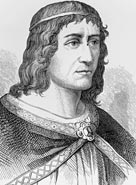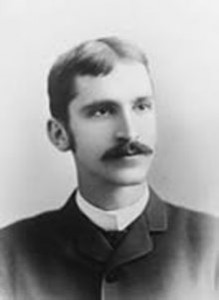Many teachers are caught up in the contemporary fascination with tracing their genealogy: the blood lines and family histories that have shaped their bodies, attitudes and personalities. But what of our professional thinking, pedagogies and ethics – who has wormed their way into our professional DNA? What would our collective and individual professional ‘family’ trees look like? Are there some undiscovered interlopers? Who do we think we educators are?
A few weeks ago I watched some English twit moved to tears by his genetic, millennium-old and somewhat tenuous link to English royalty on the genealogy television program, Who do you think you are? Those of us in the Western education tradition also have royalty in our professional DNA. King Alfred the Great was a great educator and educational theorist, who shaped our collective professional consciousness. ‘The saddest thing about any man, is that he be ignorant,’ he once wrote, ‘and the most exciting thing is that he knows.’
I once quoted our Alfred in a short presentation to a group of doctors on the subtlety of the meaning of ‘informed’ when seeking a patient’s ‘informed consent’ for a medical procedure. I argued that ‘informed’ means ‘knowing’ in the Alfredian sense and not simply ‘having being told’. One or two doctors got it: most preferred the legal sense of ‘informed’.
Our ancestor Alfred saw translation as an essential technological educational tool for his times. Alfred learned Latin so that he could translate some of the key Latin texts into English. ‘It seems better to me…’ he wrote, ‘that we should translate certain books which are most necessary for all men to know into the language that we can all understand… so that all youth of free men… are able to read English writing as well’. Scholars undertook most of the work, but Alfred checked everything they wrote, and interspersed their translation with his own annotations and musings in what was probably a sort of running seminar. A thousand years later, in a defining talk to the Curriculum Directorate in S A, Ken Boston described curriculum outcomes as what children and young people ‘know, understand and can do’. A tenuous or evident link?
A, Ken Boston described curriculum outcomes as what children and young people ‘know, understand and can do’. A tenuous or evident link?
Of course, there were professional antecedents to Alfred who shaped his, and our collective western educational consciousness and others that followed that shaped the teachers of our teachers and through them us. We have a collective theoretical snowball that we have rolled around and around as we have encountered new notions, new practices, new metaphors and new imperatives. Our understanding of being ethically educative has grown and become more complex and all of our educative practices are shaped by theories, rolling onto other theories: the theories that are part of our collective professional DNA. And although we have frozen some theories from our consciousness, like Skinner’s behaviourism, we see reward based teaching practices in our own and other’s pedagogies.
What about our individual practices as educators? Who has shaped the way we draw from the collective DNA in our daily teaching? F. R. Leavis accidently shaped my DNA and influenced my ways of thinking for over 50 years. I was both young and unworldly when I went to Sydney University in 1965. My Education Department scholarship providers decided that I should study English Literature (and History) but which English course?  The Faculty had had a major and acrimonious split the year previously between the Leavis-ites and the Wilkes-ites. The latter believed in a historiographical approach; literary criticism embedded in understanding the time the author wrote. The Leavis followers, as I understood it at the time, believed the work should stand as a piece of art, and criticised within its own world, timelessly. We freshers were lobbied to choose as if our souls were at stake. The Wilkes-ites wore suits and had very long reading lists; the Leavis-ites, like the Tomlinsons and Howard Jacobson, were passionate and had long hair and very short reading lists (no historically-related texts) and potentially sexy studies – D H Lawrence! I became a Leavis-ite, was imbued with the Leavis-gene, and to this day, believe, apparently in a somewhat unsubtle understanding of Leavis, in close reading and detailed textual analysis of literature over, or even instead of, an interest in the mind and personality of the author: reading my students’ work this way, as well as teaching literary analysis and looking at art, this way.
The Faculty had had a major and acrimonious split the year previously between the Leavis-ites and the Wilkes-ites. The latter believed in a historiographical approach; literary criticism embedded in understanding the time the author wrote. The Leavis followers, as I understood it at the time, believed the work should stand as a piece of art, and criticised within its own world, timelessly. We freshers were lobbied to choose as if our souls were at stake. The Wilkes-ites wore suits and had very long reading lists; the Leavis-ites, like the Tomlinsons and Howard Jacobson, were passionate and had long hair and very short reading lists (no historically-related texts) and potentially sexy studies – D H Lawrence! I became a Leavis-ite, was imbued with the Leavis-gene, and to this day, believe, apparently in a somewhat unsubtle understanding of Leavis, in close reading and detailed textual analysis of literature over, or even instead of, an interest in the mind and personality of the author: reading my students’ work this way, as well as teaching literary analysis and looking at art, this way.
My own educator’s DNA reflects my early theoretical introductions: Rousseau, Piaget and Pavlov’s salivating dogs. The giant John Dewey, whose belief in the role of education in creating a civil society, (‘education is a regulation of the process of coming to share in the social consciousness; and that the adjustment of individual activity on the basis of this social consciousness is the only sure method of social reconstruction’)  gave a language and practical framework for my purposes in becoming a teacher. And what a writer: ‘Democracy and the one, ultimate, ethical ideal of humanity are to my mind synonymous’.
gave a language and practical framework for my purposes in becoming a teacher. And what a writer: ‘Democracy and the one, ultimate, ethical ideal of humanity are to my mind synonymous’.
In mid career, Lauren Resnick and her engagement with ‘higher-order’ thinking for all students re-engaged me with the cognitive role of education – cognition – such a powerful word, the thinking part of knowing. She has pushed our understanding of cognition in education to include socially-shared cognition – what would Leavis make of that! In 1987, she argued that ‘when we speak of the civic functions of education then, we envision a culture of reason, analysis, and reflection, based on certain shared knowledge. Realizing this vision will require a civic consciousness that goes beyond the individualist one of current classroom learning models and draws on models of shared intellectual functioning…’ Dewey would like that. Me too – she is mixed into my professional DNA. And don’t let her smiley face fool you – she is a feisty intellectual and robust, finger-wagging writer who demands improvement through change.
So who features in your educational DNA? Whose genes do you glimpse in your daily work? Who is influencing you now? Unlike genetic genealogy, our professional DNA spirals, tightens and twists in response to contemporary theorists and academics, colleagues, students, spouses, progeny, movies, books, events, surprising insights, glimpses of ideas, aspirations, and half-grasped understandings of possibilities. And professional DNA just keeps spiralling… not always coherently, and often out of control!
One Response to Lessons from the past: #2